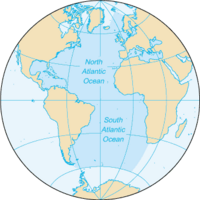
Photo from wikipedia
Abstract Seasonal to interannual predictions of ecosystem dynamics have the potential to improve the management of living marine resources. Prediction of oceanic net primary production (NPP), the foundation of marine… Click to show full abstract
Abstract Seasonal to interannual predictions of ecosystem dynamics have the potential to improve the management of living marine resources. Prediction of oceanic net primary production (NPP), the foundation of marine food webs and the biological carbon pump, is particularly promising, with recent analysis suggesting that ecosystem feedback processes may lead to higher predictability of NPP at interannual scales than for physical variables like sea surface temperature (SST). Here, we assessed the potential predictability of oceanic NPP and SST across seasonal to interannual lead times using reduced dimension, linear dynamical spatio-temporal models (rDSTM). This approach combines empirical orthogonal function (EOF) analysis with vector autoregressive (VAR) modeling to simplify the analysis of spatio-temporal data. The rDSTMs were fitted to monthly NPP and SST anomalies derived from 20 years of remote sensing data (1997–2017), considering two alternative algorithms commonly used to estimate NPP (VGPM and Eppley-VGPM) and optimally analyzed SST fields (AVHRR OISST). The local decay of anomalies provided high predictability up to three months, and subsequent interactions with remote forcing significantly extended predictability beyond the initial anomaly decay. Indeed, interactions among spatial modes associated with the propagation of major climate modes, particularly the El Nino-Southern Oscillation (ENSO), extended the predictability horizon above one year in some regions. Patterns of enhanced NPP predictability matched the location of oligotrophic gyres and transition regions between ocean biomes, where fluctuations in biome boundaries generate large biogeochemical perturbations that leave lasting imprints on NPP. In these areas, the predictability horizon for NPP was longer than for SST, although SST was more predictable over large areas of the equatorial and northeast Pacific. Our results support the potential for extending seasonal to interannual physical climate predictions to predict ocean productivity.
Journal Title: Progress in Oceanography
Year Published: 2019
Link to full text (if available)
Share on Social Media: Sign Up to like & get
recommendations!